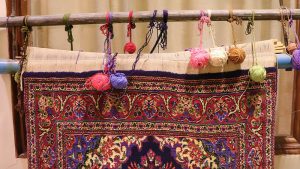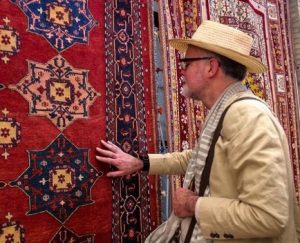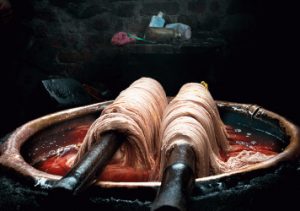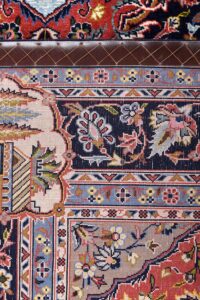If you are planning to buy a handmade Persian rug, you should know the important points in buying a handmade rug. In this post, we provide the main and important points in buying handmade carpets. Continue reading this guide to buying handmade Persian rugs.

Original handmade Persian rugs, unlike machine-made rugs, become more valuable the more they are worn! Original Persian handmade rugs, no matter where they are woven in Iran, become more beautiful due to walking, light and washing, and never lose their spectacle. Moreover, if the rug fibers are dyed using natural dyes (as in most Persian handmade rugs), the more they are used and worn, not only will their colors and patterns not fade, but they will offer more beautiful colors and gain more financial and artistic value.
Also, unlike machine-made carpets, Persian handmade rugs are completely in harmony with nature and do not cause any pollution to the environment. Also keep in mind that some of the synthetic fibers used in machine carpets are allergenic and harmful to children or people with conditions such as asthma and allergies. It is wonderful that the natural fibers and dyes used in handmade Persian carpets do not cause any allergies. In addition, handmade rugs do not generate static electricity due to the use of wool, silk and cotton.
Persian handmade rugs texture uses natural fibers such as wool, silk and cotton, and therefore keeps your room cool in summer and warm in winter. But machine-made rugs do not have this feature due to the use of plastic materials in them.
Another attraction of handmade Persian rugs is its various, refreshing and soothing patterns and colors, which can make it suitable for any style of decoration and taste.

The most important thing when buying a rug is to recognize its quality. Unlike machine-made rugs, handmade Persian rugs have different qualities due to its human hand works, differences in weavers’ cultures and environments, and differences in the materials used. They may also have mistakes or flaws. In the following, we will introduce solutions to determine the quality of handmade rugs and address the problems that may exist in a handmade carpet.
To buy a Persian rug, you should pay attention to its size. A few centimeters difference in the dimensions of the carpet in the upper and lower parts is normal and is basically a feature of handmade rugs, so it can be ignored; But a larger size difference, especially in small rugs, can be considered as a drawback.
By folding the rug in the middle and stacking it up and down, the symmetry of the design with respect to the axes that pass through the center of the carpet can be recognized. You can also measure the distance between different parts of the carpet with a meter or graduated ruler.
If the distance between the top and bottom edges of the rug to the middle of the medallion is is too much apart, the value and price of the rug will decrease.
Also note the color symmetry in the shapes woven into the Persian rug. In addition, make sure that the motifs and shapes of the design are not left unfinished in the text of the Persian carpet. Each line and branch should have its own natural shape and extension and not suddenly cut off or disappear in the middle of the pattern.

Persian carpets should be examined from different angles and in natural light. Note that naturally the color of the rugs in the pile direction may look darker than the color of the carpet in the opposite pile direction. Also, the motifs lines in the opposite pile direction are seen more clearly.

The color of the carpet should be uniform throughout its surface. Due to the traditional dyeing and the approximate dyeing operation, a slight color difference in Persian rugs is normal, but sometimes there may be a difference in color between the two ends of the carpet. Especially in carpets with a simple design or two colors, the color difference is more pronounced. Make sure that the color of the rug is rich and complete enough and that the end of the pile (in the deep) does not differ from the color of the surface; Such a color difference indicates that the carpet has been defective and has been dyed with unstable colors after weaving. You can also make sure that the colors of the rug are consistent by rubbing a damp cloth on the areas that are suspected of being repainted.
A high quality Persian rug should have a durable, shiny and flexible pile. Carpets with soft pile are less durable and more prone to absorb dust than carpets with rough pile. Rugs with soft pile can not be cleaned as well and easy as rough pile.

The most important factor to consider when choosing a handmade Persian rug is its texture. To ensure the quality of the texture, it is better to check the back of the carpet. By studying the back of the rug, you will better understand points such as the number of knots, density, the pounding of the fabrics, and the uniformity of the design. The denser and more regular the carpet texture, the higher its quality and value.
Regarding the texture of the carpet, note that the weft of single-pile carpets is never visible, and it is only in rugs of two-ply and more that are sometimes seen behind the carpet along the wefts. Also, when the woven rows are better pounded, the wefts are less visible.
When examining rugs pile, note that pile height is not a measure of carpet elegance. To control the quality of rug pile and how to polish them, you should rub the lint by hand. The height of the piles should be the same size in different parts and the surface of the carpet without any waves.
In addition to improper and irregular polishing, rough washing of Persian rug can also be one of the reasons for irregular and wavy pile.
Get informed about exclusive sales , free delivery and discount coupons %